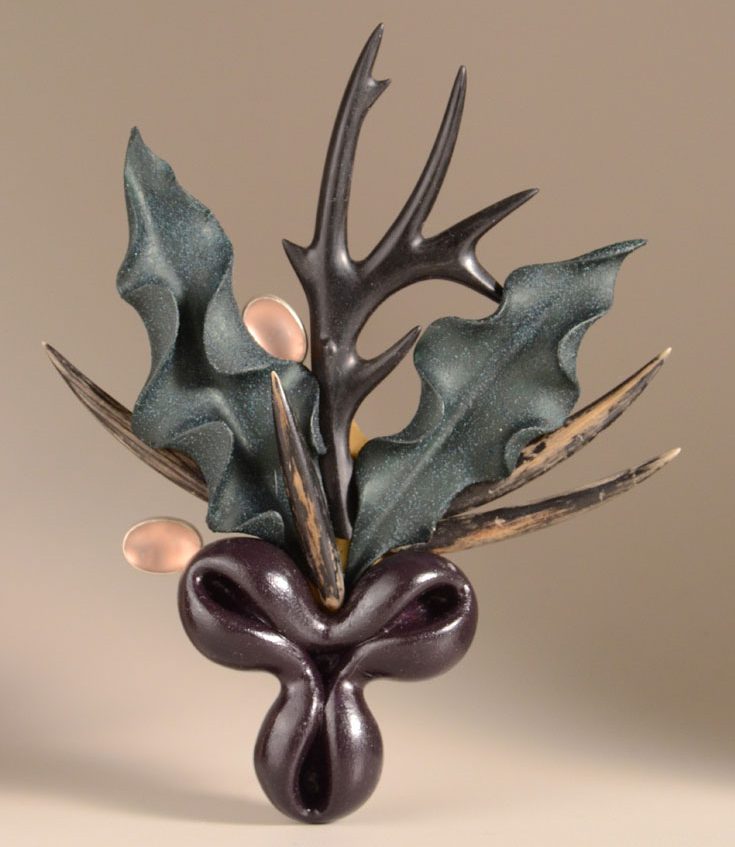Bruce Metcalf / Sin and Sensuality
“Seductive” is the word that best describes Bruce Metcalf’s jewelry, whose themes derive from pre- and ancient history, nature’s implacable persistence, and centuries of culture-based decorative art. With reference and reverence toward jewelry’s characteristic sexual coding, he makes pieces that recall American Pop, Hans Bellmer’s dolls, and Tex Avery’s cartoons – all with the impeccable craftsmanship of Carl Fabergé, and all eminently wearable. Habitually large, necklaces and brooches may be riotously colored, pastel hued, monochromatic, white or black. Abstract forms, carved from wood or plastic, contiguous or clustered, suggest both flora and human body parts. Black Hédoné contains what appears to be tracery from a Gothic stained glass window, a crab claw, a pair of plump, juicy lips, and a female pudendum – the last tinted pink. Mix and Match boasts nautilus shells – an ancient and tribal symbol of fertility – along with leaf-like forms that suggest genitalia. Surfaces are smoothly sanded, further invigorating the sense of silky sensuality. Sometimes layered and seemingly chaotic, each work is admirably engineered – harmony conquering entropy.
Despite the provocative title, Metcalf’s latest work probes deep philosophical issues. The 6th century Roman philosopher, Boethius, wrote “Nunc fluens facit tempus, nunc stans facit aeternitatum,” in English: “The now that passes produces time, the now that remains produces eternity.” Bowing to the latter precept, the mass of undulating elements that comprise his Delrin® and sterling silver brooch, Nunc Stans, presents itself as an acknowledgement of eternity by recalling the primal squirts that begin human life; but, at the same time, the forms appears in time-lapse, or stop-action, imagery – equally referencing the eternity in which nothing happens but where existence continues identical and unimpeded, in perpetuity.
A prolific writer and theorist on crafts, Bruce Metcalf is co-author (with Janet Koplos) of Makers: A History of American Studio Craft (2010). Metcalf was named Master of the Medium in Metal/Jewelry by the James Renwick Alliance in 2013; in 2014 he was designated a Fellow of the American Craft Council. His jewelry is represented in many museums, most notably the Metropolitan Museum of Art and Museum of Arts and Design in New York; Philadelphia Museum of Art, Philadelphia; The Museum of Fine Arts, Houston; Victoria and Albert Museum, London; Montreal Museum of Fine Arts, Montreal; and Museum of Contemporary Art, ‘s-Hertogenbosch, The Netherlands.
Artist Statement
Jewelry, sex, and sensuality have been conjoined since the dawn of civilization. The oldest recorded human jewelry is more than 110,000 years old. It’s drilled nassarius shells, some of them colored with red ochre. Those shells are similar to the cowrie, which is still used for ornament on several continents. Both the nassarius and the cowrie have a slot-like opening in an oval shell, resembling nothing so much as female genitalia. It doesn’t take too much imagination to realize that this very early jewelry was about fecundity and all the manifestations of human sexual desire.
Things haven’t changed much in 100 millennia. Jewelry is still about sex and desire. Engagement rings and wedding rings speak of sexual exclusivity, after all. Even male jewelry like military medals and ribbons speak of manliness and virility. But these images are coded and abstracted, so nobody has to face the facts directly. Jewelry lets us raise the subject of sex without mentioning it.
As for sensuality, what could be more sensual than the glow of gold and the sparkle of diamonds? While contemporary jewelers might reject the symbolism of preciousness, the seductive appeal of classic jewelry materials is undeniable.
What I propose is that those two ancient subjects, sex and sensuality, can be repurposed for the 21st century. The imagery must be familiar, but it can’t be traditional. And it must be coded, just like it always was. To depict plain phalluses and breasts would be too much like pornography: blunt and unpoetic.
There needs to be a certain amount of displacement. A distance, but not too much. So I offer clefts and blossoms, navels and seeds, antlers and leaves. These images may seem innocuous at first. But upon consideration, it will become obvious that some of them are reproductive in nature, like flowers and fruits. Others are abstractions of genitalia, like clefts and seeds. My imagery, indirect and suggestive, creates a potent tension with the veiled subject.
My goal is to make jewelry that is beautiful, sexy, and sometimes a little disturbing. Like a dark, handsome man in a beautiful suit and long, black hair. Or a voluptuous woman, with parted lips and half-closed eyes, gazing at you from across a smoky room.







